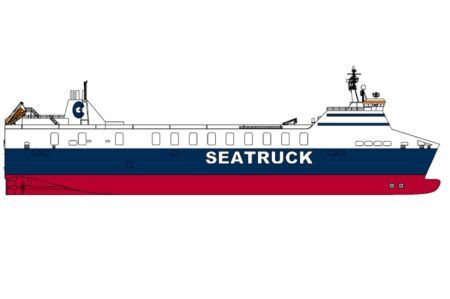
Flensburger Schiffbau-Gesellschaft’s latest newbuilding, “Seatruck Progress” (Hull No. 746), was today successfully named and launched. She is the first of four identical ships ordered by the English shipping company Seatruck Ferries Ltd.
“Building four ships one after another for a single customer has not been an everyday occurrence in the history of our shipyard”, said FSG Managing Director Peter Sierk. “Because of this, the successful co-operation with Seatruck had been all the more pleasing, he added. Seatruck has proved to to be a reliable, reputable and professional partner who understands his business. We have been allowed to open a door into the future for the owner with our innovative designs and technology.”
The four sister ships will be delivered by Flensburg to their owner between November this year and June 2012 and are intended mainly for service in the Irish Sea. The ships are 142 metres long and 25 metres wide. Each boasts a freighting capacity of 2,166 lane metres on four decks and can also carry up to 151 trailers.
These four vessels from Flensburg are the most modern and efficient in the Seatruck fleet. They will in future also be the biggest ships to operate out of the northwest English port of Heysham. It was the size of this port that determined the length of the newbuildings – maximum 142 metres allowing for the greatest possible load and optimal manoeuverability in a port with only limited available space. That’s also why the deckhouse is located forward – to guarantee unhampered loading of the upper decks.
Inside each of the four new Flensburg-designed ships are two modern MAN Common Rail main engines, which provide a whopping 8000 kW but which are capable nonetheless of meeting the most rigorous emission and fuel consumption demands.
Peter Sierk said: “Because limits will get even lower over the next few years, our aim first and foremost is to deliver ships which already meet the standards the future will demand. That means not only emission levels, but also fuel consumption. Once again we are setting benchmarks with our innovative new designs. We are also systematically treading a path to enormous reductions in fuel consumption levels because our ships consume up to 30 percent less fuel than conventional designs. In developing these ships, FSG engineers also had to pay particular attention to the unfavourable weather conditions in the Irish Sea. Designing a RoRo ferry for the often difficult and rough Irish Sea means creating sea-holding characteristics which are well beyond the normal demands of that class. In the responsible manner now typical of FSG we also exceeded currently applicable stability criteria”, Peter Sierk explained.
An additional important requirement aspect in the building of these four ships in Flensburg has been to provide the fastest possible loading and unloading in port. Modern SAT lashing systems are being utilised, which make manual lashing largely superfluous. “Our personnel have met all these demands brilliantly”, said a satisfied Peter Sierk, whose yard has at the same time entered new territory with the building of these ships. “With this ship type, we are expanding our portfolio by adding smaller but otherwise extremely efficient ships. In this way we will be even more attractive to many customers on a keenly contested global market”, he said. Current orders ensure work at the yard up to and into 2013. Apart from the four RoRo freight ferries for Seatruck Ferries, the yard is building another three freight ferries for Ulusoy Sealines in Turkey. Further projects, which will secure work for the more than 700 shipbuilders at the Flensburg shipyard, are currently in the planning stage.
We use cookies to improve your experience. By continuing to use our site, you accept our Cookies, Privacy Policy,Terms and Conditions. Close X